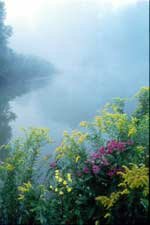|
|
|
|
|
|
|
|
|
 |
|
|
|
|
|
|
|
|
|
|||||
Recommendations  and next steps The Citizens' Bioregional Plan for Northeast Ohio recommends that we change our thought and practice in the following ways: Adopt a new vocabulary to describe the region. The old vocabulary describes an old urban core competing against new suburbs and outer counties. The new vocabulary describes a network of high density centersurban cores, edge cities, Western Reserve townsexisting in balance with open space and rural areas. Maintain and redevelop existing cities and towns. Much of the region's new housing construction could occur as infill development in existing urban areas or as conservation development subdivisions adjacent to town centers. Rural development programs should enhance the viability of family farms. Begin a major campaign to preserve open space. Now is the time to create an Outer Emerald Necklace for the next generation. If we wait much longer, the land will be gone. A parallel effort should work on improving urban parks and increasing public access to Lake Erie. Change transportation priorities. Transportation investments should promote quality of life in existing urban areas by creating great public spaces that are not dominated by cars. The urban centers of the region should be efficiently linked by alternative modes of transportation, such as light rail. Create new partnerships at the regional level. These partnerships should include not only citizens and organizations in Northeast Ohio, but also the State of Ohio, which must realign its policies to support urban redevelopment and open space protection. Follow-up activities Given the limited resources of a small, nonprofit organization, EcoCity Cleveland staff worked hard to make this Bioregional Plan as accurate and insightful as possible. But there were a number of limitations to our analysis, many of which were raised in our public review meetings:
Many of these tasks are technically complex and will require substantial resources. Ultimately, a detailed bioregional plan should be the work of our public planning agencies and a program of complete and meaningful public involvement. Here's how you can help:
EcoCity Cleveland |
Elegant solutions predicated In the age of cheap energy we did not pay much attention to locality. Wastecall it ecological incompetencewas subsidized by cheap fossil energy. But in the century ahead, powered by sunlight, we must learn how to rebuild communities and develop in ways that preserve distinctive features of landscape, local ecology, and culture. We will need "elegant solutions predicated on the uniqueness of place," in John Todd's words. Elegance in this sense means:
In the decades ahead the rewards will go to the ecologically competent who understand their places and regions. David Orr,
|
||||
Banyak pemain mencari slot yang memberikan peluang menang lebih besar. Dengan Slot Deposit 5k, pemain bisa menikmati permainan dengan tingkat kemenangan yang lebih tinggi dibandingkan biasanya. Ini menjadi pilihan utama bagi mereka yang ingin memaksimalkan kemenangan dengan modal kecil.
Banyak pemain berpengalaman memanfaatkan data harian untuk memilih mesin dengan slot rtp tertinggi hari ini. Ini menjadi salah satu cara untuk meningkatkan peluang menang secara signifikan. Dengan adanya RTP live, pemain bisa mendapatkan informasi real-time tentang slot mana yang lebih menguntungkan. Memilih mesin dengan slot gacor juga menjadi trik yang banyak digunakan untuk mendekati kemenangan besar.
Simbol Scatter Hitam dalam permainan slot berfungsi sebagai pemicu fitur bonus yang menguntungkan. Ketika muncul di layar, Scatter ini memberikan kesempatan untuk mendapatkan free spins atau hadiah spesial lainnya. Dengan posisi yang strategis, Mahjong Slot meningkatkan peluang pemain untuk memperoleh hadiah yang lebih besar dalam setiap permainan.
Banyak pemain slot online yang mencari permainan dengan RTP tinggi, dan Slot Gacor menjadi salah satu yang paling dicari. Game ini dikenal memiliki pola permainan yang mudah dipahami dan sering memberikan kemenangan besar. Dengan tampilan modern serta berbagai fitur bonus yang menarik, pengalaman bermain semakin seru. Tidak heran jika game ini selalu menjadi pilihan utama bagi para penggemar slot yang ingin mendapatkan cuan besar.
Dalam dunia hiburan digital yang terus berkembang, banyak orang memilih metode transaksi modern dan cepat, sehingga Slot Qris menjadi solusi praktis untuk menikmati permainan tanpa repot proses pembayaran.
Dalam dunia permainan online, banyak strategi yang bisa diterapkan, namun salah satu metode yang sering direkomendasikan oleh pemain berpengalaman adalah mencoba slot bet kecil untuk menguji pola permainan sebelum meningkatkan taruhan.
Saat ini, banyak pemain mencari platform terpercaya untuk bermain, dan Situs Toto hadir sebagai solusi terbaik. Dengan tampilan yang user-friendly, pemain dapat dengan mudah menelusuri berbagai fitur yang tersedia. Kemudahan dalam melakukan deposit dan withdraw juga menjadi salah satu faktor utama yang membuat banyak orang memilih platform ini.
Sebagai salah satu situs yang sangat populer, Situs Togel menawarkan berbagai pasaran dari negara-negara terkemuka. Di sini, pemain dapat menemukan pilihan pasaran seperti Hongkong, Singapore, hingga Macau, yang semuanya memiliki hasil pengundian yang akurat. Dengan tampilan yang sederhana namun efisien, Situs Togel memberikan kemudahan bagi pemain untuk bertaruh dengan nyaman.
Banyak pemain togel yang mengandalkan Data Macau sebagai referensi utama dalam menyusun strategi taruhan mereka. Data ini mencakup hasil keluaran sebelumnya yang bisa dianalisis untuk menemukan pola angka tertentu. Dengan menggunakan metode statistik, banyak pemain yang berhasil meningkatkan peluang kemenangan mereka. Selain itu, beberapa situs togel juga menawarkan layanan analisis data yang lebih mendalam. Oleh karena itu, memiliki akses ke data ini sangat penting bagi setiap pemain togel.
Ketika membahas permainan angka, tidak sedikit pemain yang menjadikan Toto macau sebagai pilihan utama karena menawarkan sensasi menegangkan sekaligus kesempatan mendapatkan hadiah besar.
Kinerja stabil dan dukungan teknologi terkini membuat slot server Thailand menjadi pilihan favorit, terutama bagi pemain yang mengutamakan kenyamanan, kecepatan, dan keadilan dalam bermain.
Setiap pemain memiliki preferensi sendiri dalam memilih platform permainan, namun di antara banyaknya nama besar, kehadiran Slot88 di dunia hiburan digital menjadi simbol konsistensi dalam memberikan layanan cepat, tampilan menarik, serta reputasi sebagai tempat bermain yang adil dan menguntungkan.